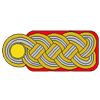It should be mentioned that a large amount of Russian World War II uniforms and boots were made in the United States (and Great Britain) as part of Lend-lease. So 1943 stand collar uniforms were often superior quality and a different color from Soviet manufacture. The flood of Lend-lease uniforms in one reason why the fall collar uniforms disappeared so quickly though some did linger to the end of the war. The foreign manufacture of Russian uniforms also explains the similarity of color in British, American and Soviet khaki uniforms.
Russian uniforms also came in two styles; cotton for summer tropical wear and wool for temperate weather. The cotton uniforms could often appear nearly white compared to darker khaki in wool uniforms.
The stand collar and shoulder board were introduced around the time of Kursk. The fall collar and sleeve/collar rank insignia were the insignia of defeat and retreat, the stand collar and shoulder board the uniform of victory and liberation.

























